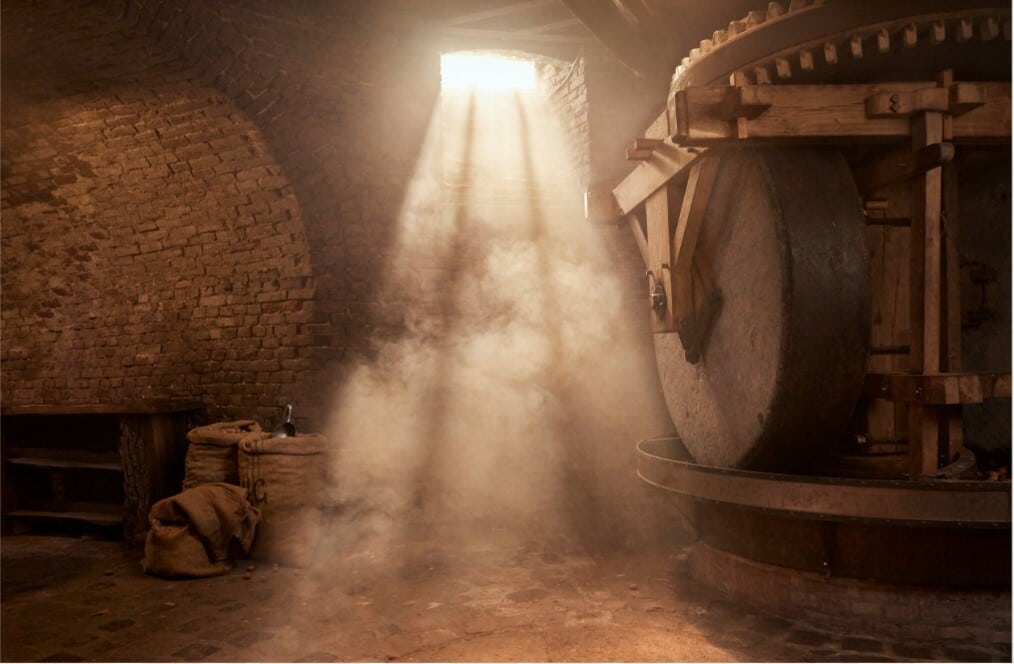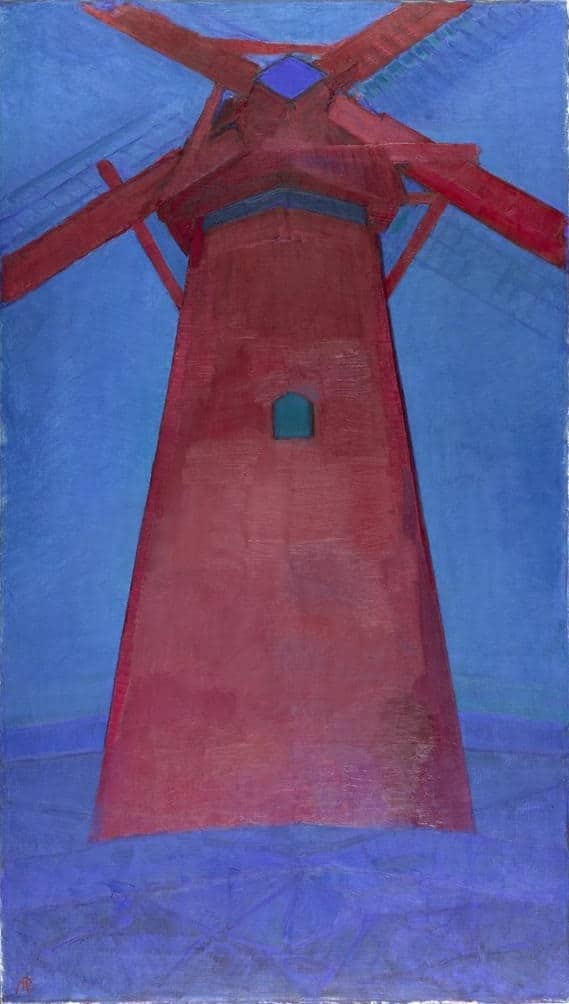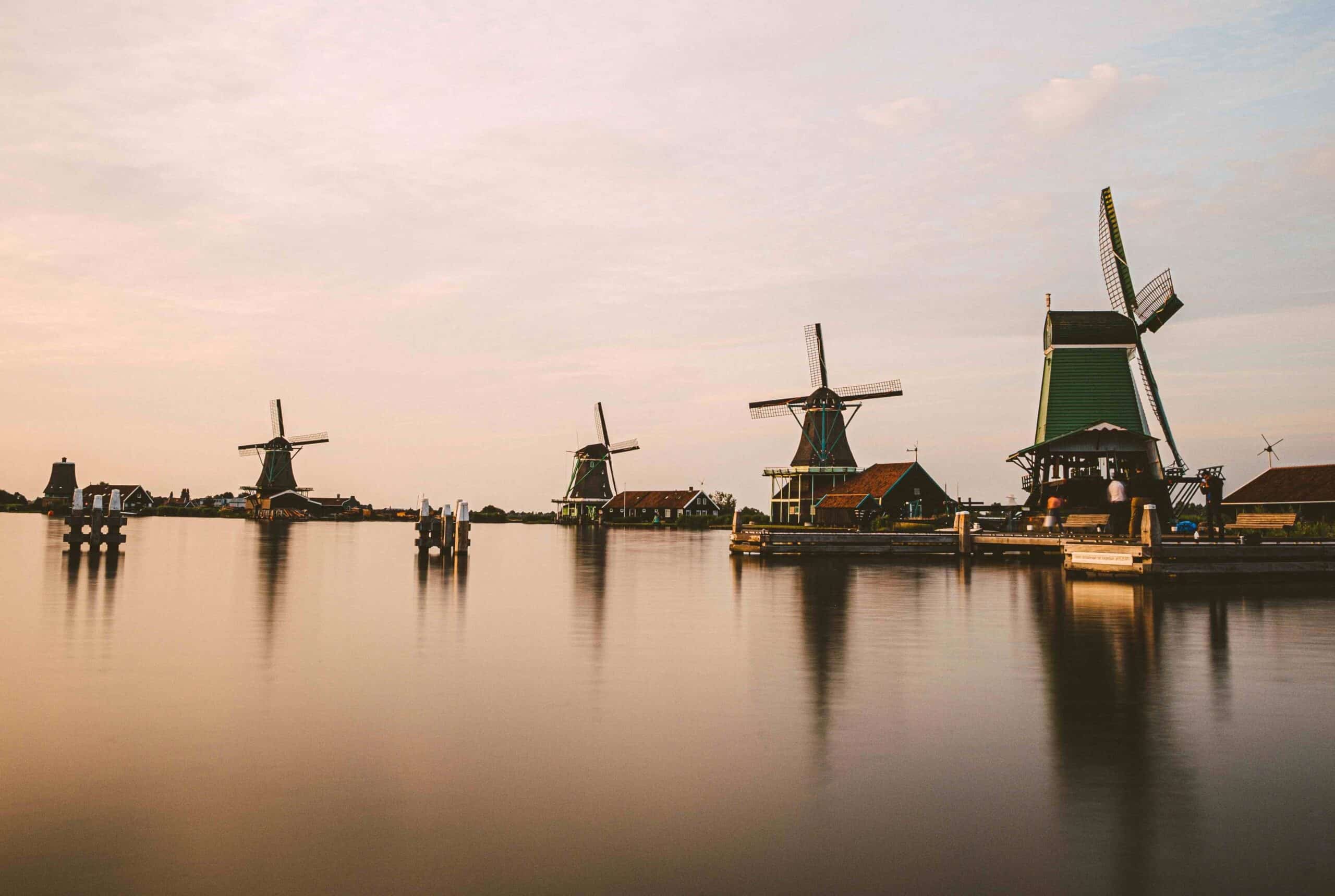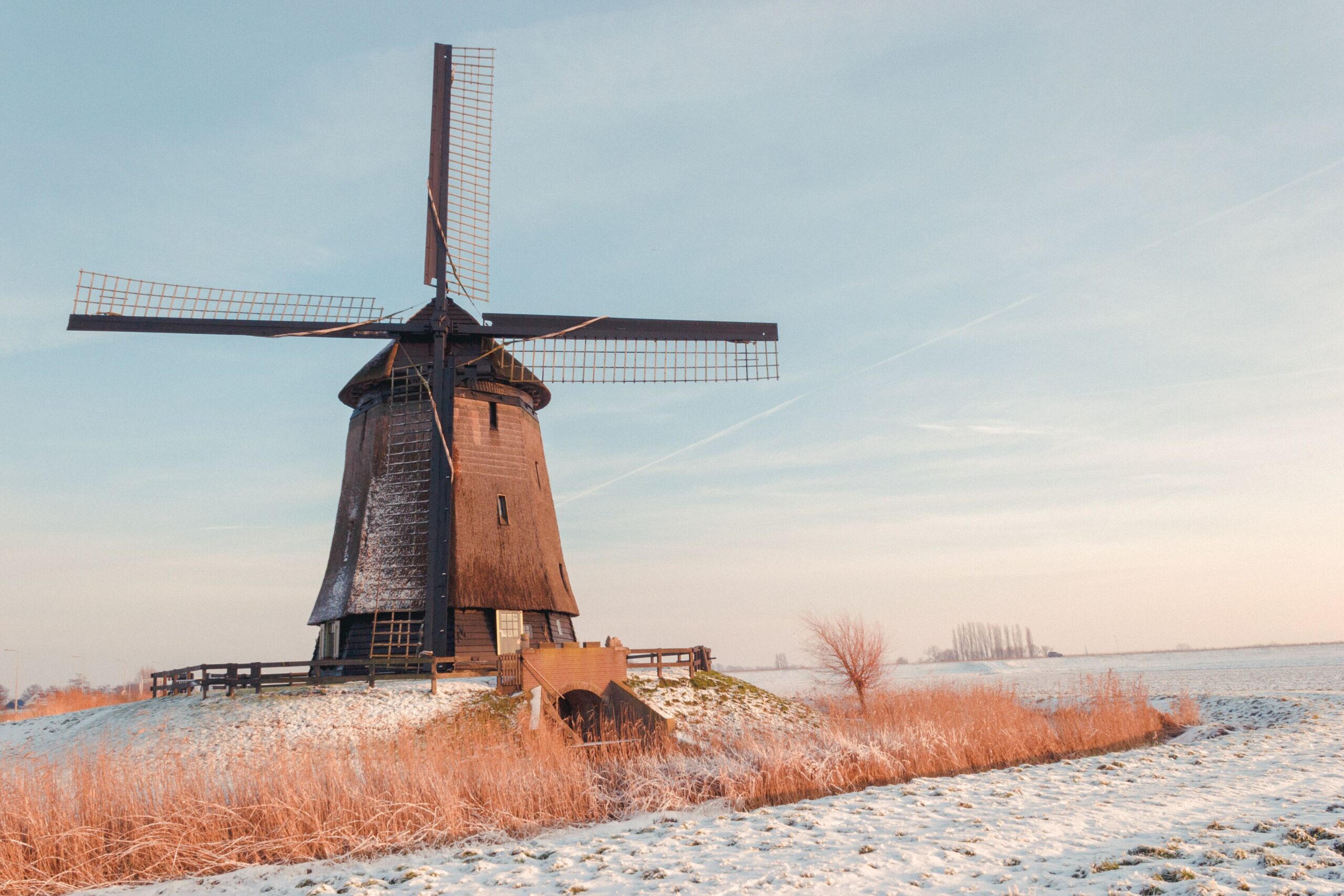The Dutch Windmill Is a Cross Between Iconic Heritage, National Pride and Polder Kitsch
One of the first things that come to mind when you think of the Netherlands is windmills. In history, they are often a symbol of freedom, loyalty to the fatherland and pride in the past. The buildings are top tourist attractions to this day. Lutgard Mutsaers, author of a book about the evergreen ‘Daar bij die molen’ (Down by the Mill) describes how a useful tool became a national icon.
De Hollandsche Molen (The Dutch Windmill Association) celebrated its centenary in May 2023. The accompanying anniversary book Van werktuig tot wereldmerk (From Tool to Global Brand) portrays the present through the lens of a young maker. The mill is doing well, better even than at any time in the last hundred years. And so, the Netherlands is a veritable paradise for the old-fashioned windmill. As a monument, it falls under heritage policy. As such it is protected, and a budget is available. There is also the Molenfonds
(Windmill Fund) for additional assistance with restoration and education. It enjoys the blessing of the royal family. Tourists flock to Kinderdijk and Zaanse Schans, courtesy of UNESCO, which has upgraded these photogenic windmills to the status of World Heritage sites. The annual Mill Weekend is a popular outing for all ages and denominations. Certified hobby millers, united in their own guild, keep the business running. Nowhere else is the mill as well off as in the Netherlands. “The mill is ours,” says the jubilee association. But that still remains a question.

© Ezra Böhm
Sawmills for shipbuilding
The history of the mill is not an exclusively Dutch story. Only one type, the sawmill, was invented and (not unimportantly) patented by a Dutchman. The moment was ideal. The northern Netherlands had just freed itself from foreign domination and radically reorganized as a Republic. The sawmill revolutionized shipbuilding. The young state was able to enter the world’s oceans with the largest, best and most ships from its power base, the two provinces of North and South Holland. In their own backyard, mills transformed worthless marshland (“frog country”) into fertile polders. The “Golden Age” could now commence.
 Piet Mondrian, The Red Mill, 1911, Kunstmuseum, Den Haag
Piet Mondrian, The Red Mill, 1911, Kunstmuseum, Den Haag© Kunstmuseum, Den Haag
In the strategic success story at the foundation of what is now the Netherlands, the mill plays a significant role. The mill kept the economy running on free (!) wind. There must have been thousands of them at one time. The mill was also a special kind of building. It was not only striking, it also was given its own name, it was set in motion, made noise, and effortlessly moved mountains. By the time it had been overtaken by modern technology, art and cultural historians gave the traditional mill the credit it deserved. By turning the mill into a character, a kind of hero, anything could be projected on it, most of all nostalgia. The mill had the advantage of being its own statue. Or rather, it became one when most of its counterparts had already been eliminated. As a backdrop, it was situated in an idealized low country landscape with water, meadows and cloudy skies that passes for being “quintessentially Dutch”. In 2023, there are still twelve hundred throughout the Netherlands.
The alarm bell
In 1913, Holland Express, Tijdschrift voor Kunst, Kultuur en Verkeer (Journal for Art Culture and Transport) published an emotional appeal for the preservation of the De Hoop mill, which was condemned to be demolished, on the Coolsingel in Rotterdam. It had to give way to the construction of a road. The writer of the article was Gerard van Hulzen, the first winner of the Tollensprijs. De Hoop (Hope) was not just a mill. The French painter Paul Signac had immortalized it. Other media joined the protest. The fuss was so great that its demolition was called off.
 Mill De Hoop, depicted in the painting 'Rotterdam. Le moulin. Le canal. Le matin' by French painter Paul Signac, 1906, Kröller-Müller Museum, Otterlo
Mill De Hoop, depicted in the painting 'Rotterdam. Le moulin. Le canal. Le matin' by French painter Paul Signac, 1906, Kröller-Müller Museum, Otterlo© Kröller-Müller Museum
Van Hulzen’s plea appeared under the title ‘That Our Monuments Be Spared’!!’. His heartfelt cry was well-founded and was not limited to that one case. The entire stock of mills was under pressure. The traditional method of propulsion had long since been overtaken by technology. One owner after another had an auxiliary engine installed. The structure itself would soon be deemed obsolete.
In the absence of hard economic arguments, Van Hulzen played the trump cards of Dutch history and their irreplaceable iconic value. “One should not have a low opinion about a mill, for it is one of the most beautiful, imaginative structures that our otherwise arid and sober minds have managed to create,” he wrote. The psychological blueprint for the conservation of mills was thus unfurled.
National symbol
The palpable proximity of the First World War was a pressure cooker for nationalism. In the mixture of fear of war and the need for reassurance, new symbols of unification flourished. The mill, still glowing from all the attention given to its chances of survival, was one of them. The role of a giant sentry ready to defend freedom fit it like a glove. When it came to that no tulip, lump or ball of cheese could match it.
The mill played the role of a giant sentry ready to defend freedom
The mill’s new image as an action hero pushed the folkloric stereotypes of millers as sex-hungry (merci, comfortable flour sack) and dishonest (no thanks, fiddlesticks) into the background. The vaudeville stage was the place where the mill could grow in its role.
A popular song from the period of mobilization was ‘De molen aan de vliet’ (The Mill on the Brook). The writer and singer was the humourist Jan van Laar (1872-1949), who formed a duo with his wife. In their repertoire, the mill turned out to be a dreamy realm of romance and security. Van Laar had cut short his training as a millwright to follow his girlfriend into the artist profession, so he knew what he was talking about. ‘De molen aan de vliet’ combined the theme of love in relation to the theme of loyalty to the fatherland, symbolized by the mill.
If things were going bad for the economy, the traditional mill was a beacon of the good old days
After the First World War, a pattern formed. If things were going bad for the economy, the traditional mill was a beacon of the good old days. If the economy was doing well, no one gave the mill a second thought. The first crisis occurred in 1922. ‘De molen aan de vliet’ was released as a gramophone record. Radio had not yet begun. The following year, the German economy collapsed. Holland held its breath.
On 15 May 1923, several mill-loving artists, engineers and notables convened in Amsterdam on the Herengracht for the founding of Vereniging De Hollandsche Molen, (The Dutch Mill Association) the first of its kind. Goal: the inventory of all windmills in the Netherlands and the prevention of their demolition. A year later, the economy was back on track. Despite that, in Rotterdam, the De Hoop windmill was razed to the ground.
Museum piece
To mark the first anniversary of the Association, The Hague humourist Willy Derby wrote a campaign song to recruit donors. ‘Holland, conserve your mills’ was an urgent exhortation to allocate funds for this. The government came up with a new measure. Demolition without a permit was already a punishable offence. From now on, this also applied to secretly preparing to do so. The Association itself launched a competition for the improvement of the efficiency of the blades.
The new mill law regulated working hours and hastened the end of the era of the craft mill with its dependence on the wind. An unprecedentedly large round of demolition then put paid to the characteristic mill skyline of industrial Zaandam. Tempers ran high. Shame on you for unceremoniously getting rid of these hardworking labourers and welfare workers! The communist newspaper De Tribune was the only one to stand up for the exploited mill workers, the real heroes of the story.
The best boost for the mill as a national symbol was the Olympic Games in Amsterdam in 1928
As a plaster on the wound, Zaandam received the first mill museum in 1928. Prince Hendrik, the husband of Queen Wilhelmina, came to cut the ribbon. The best boost for the mill as a national symbol was the Olympic Games in Amsterdam in the same year. It figured on all kinds of souvenirs. But the mill itself remained under threat.
Tipping point
The tenth anniversary of the Association fell in 1933, in the middle of the Depression. Willy Derby was present again, this time with ‘Klip klap molenlied’, a cover of a German song about a water wheel in the Black Forest, translated to the Dutch windmill. He had incorporated all kinds of language jokes into it. The best foreign advertisement for the mill was the feature article in the American magazine National Geographic about technology and tradition in the Netherlands. Here, artistic photography of mills, including aerial shots, proved itself a worthy successor to classical paintings of mills.
The tipping point in the public appreciation of the mill came in 1935. It coincided with the biggest windmill hit the Netherlands has ever known. ‘Het plek bij de molen’ was by the same songwriter as ‘De molen aan de vliet’. Willy Derby recorded it in Berlin in the popular German film schlager style. As the B-side of the evergreen ‘Twee ogen zo blauw’ (Two Such Blue Eyes), it seemed destined for obscurity, but the opposite happened. The infectious mill waltz was popularly redubbed ‘Daar bij die molen’ (Down by the Mill). It became all the rage. Everyone was trying to get a piece of the action.
 Tourists flock to Kinderdijk and Zaanse Schans, courtesy of UNESCO, which has upgraded these photogenic windmills to the status of World Heritage sites.
Tourists flock to Kinderdijk and Zaanse Schans, courtesy of UNESCO, which has upgraded these photogenic windmills to the status of World Heritage sites.© Moritz Kindler / Unsplash
Turning into kitsch
Among those jumping on the bandwagon was the National Socialist Movement NSB. The polder fascists cast themselves as guardians of the mill making all sorts of promises about what they would do once they came to power. Its own mill-first rhetoric missed the mark. The success of ‘Daar bij die molen’ had already done more than enough to increase popular support for the conservation of mills. In addition, the Association’s competition resulted in a new technique for streamlining the blades. Mills were suddenly being built again. That hadn’t happened in years. The side effect of the craze was the commercialization and turning of the image of the mill into kitsch in the form of knickknacks and mill-in-the-snow photography as a genre. The latter culminated in the harsh winter of 1939-40.
The polder fascists of the National Socialist Movement cast themselves as guardians of the mill
During the Second World War, the mill stood for freedom from foreign domination, a well-known trope in Dutch history. ‘Daar bij de molen’ stood in as an alternative national anthem. Quite a few millers sent coded messages to the resistance via the position of the blades. In the meantime, the occupier transferred all mill matters to the Departement van Opvoeding, Wetenschap en Kultuurbescherming. (Department of Education, Science and Cultural Conservation). That body paid out the first restoration grants. It was a good time for the organized conservation of mills.
The Vereniging De Hollandsche Molen picked up where they left off after Liberation. Over the course of the 1950s, the young generation turned away from their parents’ music. ‘Down by the Mill’ was one of the rare songs from the old days that managed to remain popular. The first line of the chorus has become a fixed expression. The sound of the title alone is the perfect soundbite for dubbing The Netherlands, the Land of Windmills.
 The side effect of the mill craze was the turning of the image of the mill into kitsch in the form of mill-in-the-snow photography as a genre.
The side effect of the mill craze was the turning of the image of the mill into kitsch in the form of mill-in-the-snow photography as a genre.© Uitbundig / Unsplash
Back in time
The mill has a longer history in Belgium and northern France, where it assumes a more modest place in the collective memory and enjoys less of a budget, even though there is no shortage of mill friends and experts. There is a good story behind them, but that is not used to make their conservation a matter of national honour. The heyday of mills is too far in the past and too few have been preserved.
The mill was the engine of the economy of the County of Flanders, the pearl of the Low Countries in the late Middle Ages. The fulling mill, for example, revolutionized the processing of raw wool into supple cloth, the export product of that flourishing period. Lawyer and molinologist Karel Van den Bossche (1933-2017) called the mill a game changer on the cusp between hopeless agricultural feudalism and urbanization and artisanal specializations united in guilds, He qualified that period as Europe’s First Industrial Revolution. His self-published study De molen als symbool (The Mill as a Symbol, 1998) is considered a standard work.
Van den Bossche is also the founder of the Centre for Molinology annex Mill Museum in Sint-Amands on the River Scheldt.
Recent history
‘Daar bij die molen’ was also a hit in Flanders. Perhaps that played a role in the founding of the non-profit organization De Belgische Windmolen vzw in 1937. One of the initiators was Alfred Ronse (1876-1962), author of De windmolen
(The Windmills, 1934). After the war, Christian van de Walle de Ghelcke (1917-2005) put his back into it. His family once owned two windmills on the Bruges rampart. The contact between the Belgian and the Dutch mill association led to the joint database of all mills in the Netherlands and Belgium that still exist and all those mills of which only descriptions or images remain. The system of unique identification numbers was devised by Anton ten Bruggencate, one of the founders of De Hollandsche Molen.
During the Second World War, the song 'Daar bij de molen’ stood in as an alternative national anthem
In 1976, the Vereniging Molenzorg Vlaanderen took the place of De Belgische Molen. Lieven Denewet has been the driving force behind it for many years. He is also editor-in-chief of the molinological journal Molenecho’s. Last year his book was published about West Flemish windmills that are still running and can be visited by appointment. Of the one hundred and seventy-two mills, sixty-one fall into that category. A well-known mill that is currently on the nomination list for thorough restoration is the oil mill De Nieuwe Papagaai (The New Parrot) on the Bruges ramparts.
Crossing borders
The ARAM (Association Régionale des Amis des Moulins),
currently operating in the north of France, oversees the existing mills. At one time the area must have been positively strewn with them. There are only a few dozen left. The Noordmolen van Hondschote, purportedly built in 1127, is a national monument. Sint-Winoksbergen (Bergues), the oldest town in the region, owes its name to the first patron saint of millers.
 Snapshots of mills from the book Hollandsche Molens (1927): saw mill De Held Jozua in Zaandam and paper mill De Schoolmeester in Westzaan, both in North Holland.
Snapshots of mills from the book Hollandsche Molens (1927): saw mill De Held Jozua in Zaandam and paper mill De Schoolmeester in Westzaan, both in North Holland.The only mill museum in France is located in Villeneuve d’Ascq. It was realised with financial support from the European Interreg programme and opened in 1995. There is a working oil mill from Arnèke (Arneke), the only one of that type, a working grain mill from Bambècque (Bambeke) and a retired water mill from Vers-sur-Selles.
The latest cross-border initiative is called Via Molina in contemporary tourist Latin. For the time being, only Denmark, Germany (initiator in 2018) and the Netherlands are participating in the network of signposted mill routes. The International Molinological Society supervises the content of the project, and the European Commission gives it financial support (see viamolina.eu). In so doing, the mill enters a new phase as a legendary relic of a shared European past.












